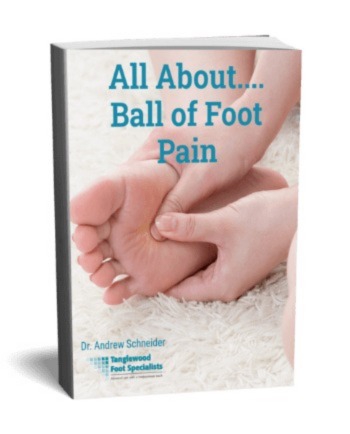 Do you feel like you have a marble under the ball of your foot? Do your toes get numb when you’re wearing your favorite shoes? Do you feel better barefoot than when you’re wearing shoes? You might be suffering from a Morton’s neuroma. Are you are feeling persistent pain in the ball of your foot? Give Houston podiatrist Dr. Andrew Schneider a call for an immediate appointment.
Do you feel like you have a marble under the ball of your foot? Do your toes get numb when you’re wearing your favorite shoes? Do you feel better barefoot than when you’re wearing shoes? You might be suffering from a Morton’s neuroma. Are you are feeling persistent pain in the ball of your foot? Give Houston podiatrist Dr. Andrew Schneider a call for an immediate appointment.
What is a Morton’s Neuroma?
A neuroma is an enlargement or thickening of a nerve. A Morton’s neuroma describes a thickening of nerve tissue between the third and fourth toes. Even though you may feel pain or numbness in your toes, the neuroma is between the metatarsal bones. It’s also possible to have a neuroma affecting other toes as well. A neuroma is a painful foot condition.
The involved nerve thickens because of mechanical pressure on it. This can be due to having either flat feet or a high-arched foot. Foot deformities, such as bunions or hammer toes, can also increase the pressure. The metatarsal bones on either side of the nerve causes pressure on the nerve. There is also a ligament between these bones that also add to the pressure on the nerve. All these factors cause the nerve to thicken. It also becomes inflamed and leads to foot pain.
How is Morton’s Neuroma Diagnosed?
The proper diagnosis of Morton’s neuroma is clinical. Based on the type of pain you’re experiencing and the location of it, I can diagnose it confidently. The best time to come in is when you first notice symptoms. As the neuroma progresses, it becomes more painful. It's best to diagnose a Morton’s neuroma early. This lessens the chances that you will need a more invasive treatment.
I will always take an x-ray. A neuroma doesn’t appear on an x-ray, but it allows me to rule out issues that can mimic a neuroma, such as a stress fracture. I also may examine the area with a diagnostic ultrasound machine. In cases where the diagnosis may not be as obvious, I may send you for an MRI.
Symptoms of a Morton’s Neuroma
Pain When Wearing Narrow Shoes
 Women suffer from neuromas more than men because of the shoes they wear. Your narrow, tight-fitting shoes put more pressure on the inflamed nerve. High-heeled shoes will also cause pain.
Women suffer from neuromas more than men because of the shoes they wear. Your narrow, tight-fitting shoes put more pressure on the inflamed nerve. High-heeled shoes will also cause pain.
Pain in the Ball of Your Foot
Nerves are funny things. You may have friends who have had a Morton’s neuroma, but their pain is different than yours. You may feel a sharp pain, a dull pressure, or even a numb sensation.
Numbness or Pain in Your Toes
The enlarged nerve is still active. It continues on into the toes. When there is pressure on the neuroma, it causes there to be numbness or pain in the adjacent toes.
Conservative Treatment Options for a Morton’s Neuroma
Change of Shoes
It's time to retire your ill-fitting shoes. You should make a change to a wider shoe. This puts less pressure on the metatarsal bones. This, in turn, will put less pressure on the nerve. I often recommend that you should wear the widest shoes that you can keep on your feet. You also want to avoid worn-out shoes.
You also should avoid wearing high heels. They shift more pressure to the ball of your foot and increase the inflammation and pain. Also, avoid pointy-toed dress shoes. They squeeze the front of your foot. This puts lots of pressure on the nerve. When it comes to a neuroma, shoe type matters.
Custom Orthotics for Morton’s Neuroma
 A custom orthotic is a shoe insert that I make specifically for your feet. I design it to control abnormal foot biomechanics and add stability and efficiency to your feet. The orthotic redistributes the mechanical pressures of your foot. It alleviates the extra pressure on the Morton’s neuroma.
A custom orthotic is a shoe insert that I make specifically for your feet. I design it to control abnormal foot biomechanics and add stability and efficiency to your feet. The orthotic redistributes the mechanical pressures of your foot. It alleviates the extra pressure on the Morton’s neuroma.
A common feature of a custom orthotic used to treat Morton’s neuroma is a metatarsal pad. By supporting the metatarsal arch, the orthotic separates the metatarsal bones. This lessens the pressure on the nerve. The inflammation will be able to decrease, which alleviates the pain.
Anti-Inflammatory Medication
The pain associated with a Morton’s neuroma is due to inflammation of the nerve. Because of this, anti-inflammatory medication can be helpful to reduce that inflammation. When the inflammation is reduced, the pain subsides as well.
Cortisone Injections for Morton’s Neuroma
Using a cortisone injection is often a better option than oral anti-inflammatory medication. This is because the injection stays local to the area of the inflammation. The oral medication goes throughout the entire body. This usually allows for a quicker relief of inflammation and pain. Most people with a Morton's neuroma feel significant relief after one cortisone injection. That's why it's such a common treatment option.
I often get asked how long does injection therapy last. The direct effect of the cortisone lasts about two weeks. The results, however, should be lasting. In some cases, one injection is all that you need to be out of pain. You’ll be back to regular activity before you know it.
It’s important to note that the steroid injection does not eliminate the Morton’s neuroma. It reduces the inflammation and the pain. It is possible for the pain to come back at some point in the future. Depending on the time frame, we may elect to use another injection at that time.
Surgical Treatment of Morton’s Neuroma
Conservative measures are successful to relieve pain from a Morton’s neuroma about 2/3 of the time. You may consider surgery when the pain persists after you've tried conservative therapy. The surgery to correct a Morton’s neuroma is straightforward. I’m able to see the neuroma itself and remove it. Without the inflamed piece of the nerve, you will no longer have pain. It is a definitive surgical procedure.
During surgery, a piece of the nerve is removed. Because of this, you may experience numbness between your toes. Most people are not bothered by the numb sensation, however. It pales in comparison to the pain they were feeling. If you are concerned about the potential numbness after surgical treatment, let me know and we will discuss it.
After foot surgery to remove a Morton's neuroma, you are able to bear weight immediately. You will walk in a surgical shoe for approximately 2-3 weeks afterward in order to allow the incision to heal. Most people feel a significant improvement of their pain almost immediately after surgery.
Who Treats a Morton’s Neuroma?
A neuroma is a common foot condition. A Houston foot doctor is best qualified to diagnose your Morton’s neuroma and provide you an appropriate treatment plan. Dr. Andrew Schneider will partner with you to discuss the options you have to treat your neuroma pain. Contact our office for an immediate appointment with Dr. Schneider.






















